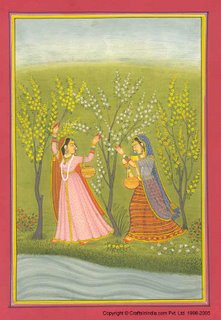ragamala paintings [music / art]
 Raga Lalita
Raga Lalita"The Kangra Miniatures of the Pahari School made a mark in the 18th century. Though influenced by the Mughals, the Kangra School retained its distinctiveness. The paintings were naturalistic and employed cool, fresh colors. The colors were extracted from minerals, vegetables and possessed enamel-like luster. Verdant greenery of the landscape, brooks, springs were the recurrent images on the miniatures. Texts of the Gita Govinda, Bhiari's Satsai, and the Baramasa of Keshavdas provided endless themes to the painters. Krishna and Radha as eternal lovers were portrayed rejoicing the moments of love. The Kangra miniatures are also noted for portraying the famine charm with a natural grace. The paintings based on Ragmalas (musical modes) also found patronage in Kangra."

Ragini Vasanti
"Here, celebration of spring is shown amidst the yellow and white blossoms of trees while a pair of belle charmed by the nature’s beauty are plucking flowers and rejoicing the season. The painting is based on Raga Vasanti. Ragini Vasanti represents advent of spring marked by new leaves, blossoming of flowers and songs of birds."

Raga Kalinga
"The painting personifies Raga Kalinga, one of the sons of Raga Dipaka. In the painting Raga Kalinga is visualized as Krishna resting on a lotus flower cushion spread on a serpent. The crown decorates the head while kundals (the rings) adorn the ears. His flute is potent enough to enchant the universe. His beautiful eyes, arched eyebrows and a garland of flowers around his neck enthrall the heart.
"Between 14th-16th centuries a wave of Krishna worship swept India. Hindu devotees could easily relate to Krishna who was one of like them. He was a loving god who moved among them and shared their pastoral and agricultural pursuits. Krishna worship inspired a cycle of poetry in the 16th century succeeded by a cycle of painting."
source of paintings and texts: Crafts in India


0 Comments:
Post a Comment
<< Home